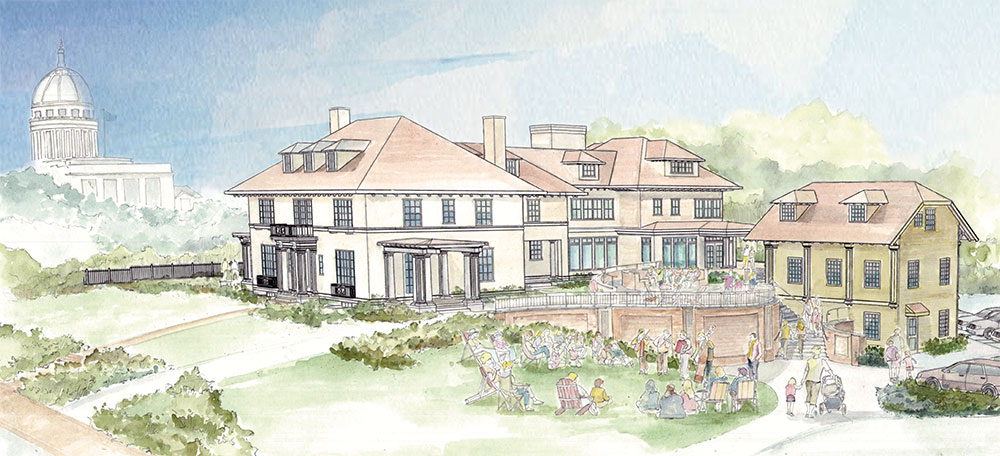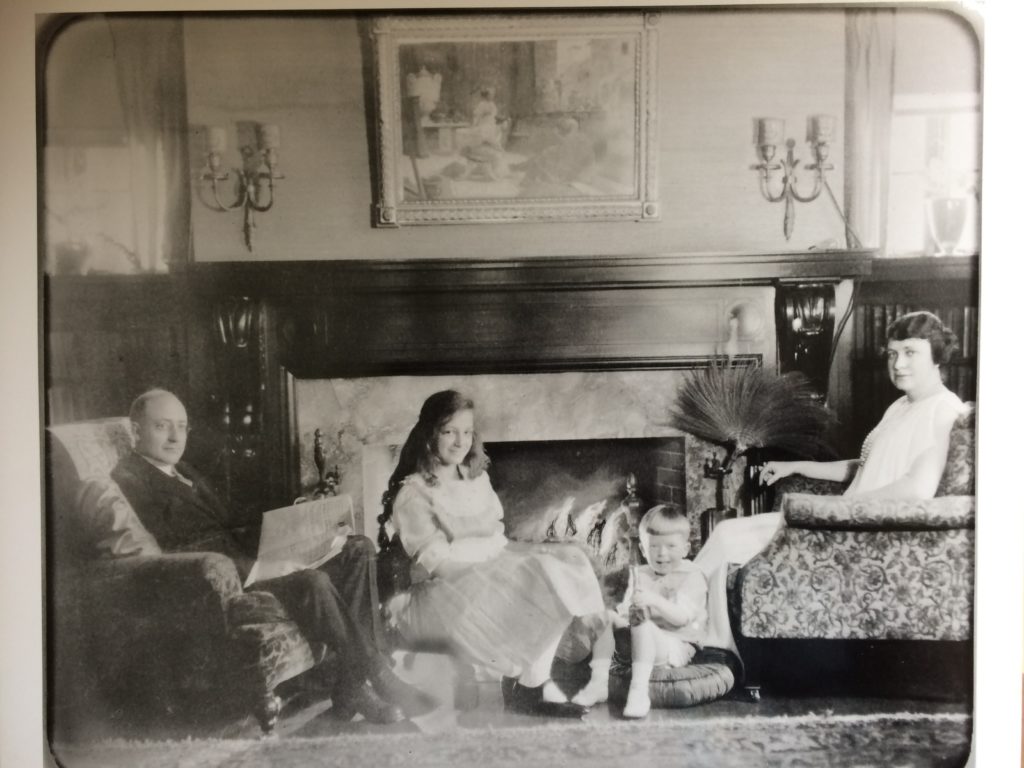Article written by Maureen Milliken and was originally published in Mainebiz on July 12, 2021.
The tattered paper banner reads “Bong Hits 4 Jesus” in crudely rendered black letters, and it’s one of the more recent artifacts on display at Augusta’s developing First Amendment Museum.
The banner may not seem like a museum piece, but it’s an illustration of the museum’s vision, one that’s fueling a soon-to-be-launched $14 million capital campaign.
“For a long time, museums really shied away from the present tense,” says Christian Cotz, executive director. But the museum planned in Augusta will “show how history matters in real life.”
The museum is at 184 State St., next door to the governor’s residence and in the shadow of the Statehouse, a prime location for school groups and local visitors. But those involved in its development have a much bigger scope in mind.
That scope is already growing with online presentations that relate current events to First Amendment freedoms, and have been attended by people from around the world.
“We’ll start in Maine, but it’s a national effort,” Cotz says. “Give us 10 years.”
No dusty artifacts under glass
The project is catching momentum at a time when the perception of what makes a museum is evolving, and during an elevated national discussion about what makes a democracy.
The museum won’t be “dusty artifacts under glass,” but an interactive experience that will help visitors relate the First Amendment to their lives, Cotz says.
The banner that reads “Bong Hits 4 Jesus,” which the museum is raising $2,500 to preserve, is an example of that. It was created by Alaska high school student Joseph Frederick, who displayed it at an Olympic torch relay event in 2002. He wanted to see “if the First Amendment still exists in this town.” The principal, Deborah Morse, wasn’t amused and Frederick was suspended.
The Supreme Court ultimately ruled in Morse v. Frederick that schools can restrict student speech when it can be perceived as promoting illegal drug use. The case is similar to one the court ruled on in June, finding a cheerleader shouldn’t have been punished by her school for an F-bomb-fueled Snapchat rant, since it was off-campus expression.
The cases are among a handful that define the limits of student free speech. Cotz says the museum plans to use examples like those to make the First Amendment relevant.
“We want people to ask, ‘How does the First Amendment affect my life?’” he says.
A big part of that is helping people understand what the First Amendment is. A 2019 Freedom Institute survey found 71% of Americans can name one of the amendment’s five freedoms, with the majority knowing “freedom of speech.” Only 1% can name all five — speech, religion, press, assembly and to petition the government on grievances. And only 4% can name four.
The museum is apolitical, looking to empower people through knowledge.
“One of the things we hope to do in the exhibits is have people ask, ‘What if we didn’t have this freedom in America? What would it look like?’” says Genie Gannett, a cofounder with her sister, Terry Gannett Hopkins.
The underpinnings of a museum that will do just that is taking shape, but it’s been a slow process.
Local partners, strong team
Plans were first approved by the Augusta Planning Board in November 2018. Since then, extensive work has been done to the house to get in in shape to begin renovations.
In the past year, things have taken shape, with the capital campaign kicking off a soft launch with a $150,000 gift from Kennebec Savings Bank in November.

“I genuinely believe that the First Amendment Museum will help people of all ages know and understand their First Amendment rights,” says Andrew Silsby, president of Kennebec Savings. “It will also help our city grow economically and culturally. The museum will draw more tourists to Augusta and will be a community hub that will be a great source of pride for the citizens of central Maine.”
Cotz and Gannett say that partnerships, both locally and farther afield, are part of the museum’s game plan.
There’s no firm timeline to launch the capital campaign. For now, the campaign is being promoted by a video on the museum’s website. In March, the board agreed to create an endowment. The museum has also hired a chief development officer, Jamie O’Brien.
“She will be instrumental in helping us with the campaign,” said Deborah Williams, Manager of Outreach Engagement.
Local support is abundant. Besides Kennebec Savings, the museum has received support from law firm Preti Flaherty, which has offices a block north. Ganneston Construction, of Augusta, the general contractor on the addition, has been providing pro bono consulting.
The team has taken shape, too. Cotz became executive director in January 2020.
The museum hired an exhibit designer and project manager, Helen Riegle of HER Design in Boston. She’s done work for the Smithsonian and the National Baseball Hall of Fame. Amanda Austin, of 2A Architects, of Rockport, leads the expansion design.
Old building challenges
Prior to joining the museum, Cotz held senior leadership positions at Montpelier, the historic Virginia estate of James and Dolley Madison, which underwent a major restoration during his tenure. So it’s not his first crack at bringing an old building up to modern standards. There’s also the fact that Madison, America’s fourth president, was considered the “father of the Constitution.”
“There are a lot of parallels between the two places,” says Cotz, who spent two decades at Montpelier.
The Augusta museum’s stucco-exterior Mediterranean Revival-style building long called the Gannett House was considered a modern marvel when it was built in 1911, with electricity, a central vacuum system, and the city’s first car garage.
As Cotz and Gannett talk in what was once her grandparents’ sitting room, the lack of air-conditioning on a warm day underlines the challenges.
“It’s a big house, but there are no big spaces that you need for a museum,” Cotz says.
In the past five years, the building has undergone extensive interior and exterior work, including new windows and roof. It still needs new bathrooms, handicap accessibility, an elevator, an HVAC system.
While preliminary work on the addition gets going, the house will be further restored. Eventually it will have exhibits on how the First Amendment looks at home, with a library featuring books that have faced censorship. A teen room will help visitors “navigate the murky world of free expression on the internet,” including a multimedia interactive game that challenges visitors to spot moments when public discourse becomes uncivil.
The museum is working with the Maine Preservation Commission and the Capitol Planning Commission, which oversees the master plan for the state government campus, a stipulation when the nonprofit that owns it bought the building from the state.
For the public good
When William Gannett built the house as a wedding gift for his son, Guy, the proximity to the heart of state government was intentional.
“He wanted it to be close to the Capitol, to the governor,” Gannett, who is Guy Gannett’s granddaughter, says. The publishing family founded some of the country’s biggest magazines in the late-19th century, owned several Maine newspapers, and eventually TV and radio stations. Guy Gannett didn’t see the newspapers as a private enterprise.
“He felt what they were doing was for the public good,” she says.
Cotz says the location will still be a key piece.
“We’re within an hour of 100,000 schoolchildren,” he says.
The combination of Maine State Museum and Archives, on the other side of the Statehouse, as well as the Capitol building itself, make an exciting one-two-three punch. Cotz envisions field trips in which students visit the state museum, then visit the State House, then move on to the First Amendment Museum, to learn what part they play in it all.
For now, visitors can tour it for free, and check out panels that show what’s coming.
Cotz and Gannett say they realize that the $14 million price tag seems high — but also note it’s the same goal the Children’s Museum & Theatre of Maine set for its new building, which opened June 24.
The cause is vital, Gannett says. “As a country, we need to pay attention to the First Amendment and what it means. [The museum] plays an important role.”
Cotz says museums that are truly embracing their purpose understand their place in history. “Any museum that opens now has to take the last few years into account,” he says.
That is true, in particular, for the one they are building in Augusta.
Cotz says understanding democracy means understanding the First Amendment. “It’s the way we change our government, it’s the way we change our society, it’s the way we change our world,” he says. “If the goal is ‘to form a more perfect union,’ we have to commit, not only to talking about what the First Amendment is, but how it affects how we think, govern — how it’s put into action.”
Cotz knows that’s a big calling for a museum in Augusta, Maine. “But we can do it. We’re here to do it.”

William Gannett, whose Comfort Magazine, published in Augusta in the late 1800s, was the first magazine to reach 1 million subscribers, built the house that is home to the First Amendment Museum for his son, Guy, as a wedding gift in 2011.
Guy, in 1921, bought Portland’s two daily newspapers (now the Press Herald), as well as the Kennebec Journal and Waterville Sentinel. He sold the house in 1927, moving to Cape Elizabeth.
Genie Gannett, Guy’s granddaughter, says the museum fulfills a wish from her mother, who lived in the house as a child. When Genie herself was a child, they lived in Augusta. “Every time we’d drive by, my mother would say, ‘Oh, I wish they’d do something with the house.’”
Gannett and her sister, Terry Hopkins, began the process of buying it from the state in 2010 through a nonprofit funded by their mother. They at first planned to make it a museum that recounted the Gannett publishing and journalism history.
“But we saw it had to be more,” she says. The idea evolved into a museum that championed newspapers and the free press, then the First Amendment as a whole. “It’s a package deal,” she says.
More than a century after her great-grandfather built the house, intentionally close to state government in order to “keep an eye on it,” she says, “I feel in a lot of ways we’re fulfilling a legacy.”
Learn more about our future plans. Sign up for our e-newsletter to stay up to date with what’s going on at the First Amendment Museum.

